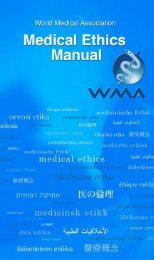the basics - World Health Communication Associates
the basics - World Health Communication Associates
the basics - World Health Communication Associates
- No tags were found...
You also want an ePaper? Increase the reach of your titles
YUMPU automatically turns print PDFs into web optimized ePapers that Google loves.
The educational intervention should be pitched at a level commensuratewith age, mental capacity, gender and environment. Programmes for adolescents,for example, might focus on reproductive health (e.g. use of condoms) along withcancer prevention and detection—breast self examinations, testicular examinationsand annual cervical smears. In young adults, <strong>the</strong> issues of communicable and noncommunicabledisease and <strong>the</strong> need for parental and childhood vaccination could bereinforced. Young mo<strong>the</strong>rs are receptive to learning about recognising and treatingchildhood illnesses. And interventions for people in <strong>the</strong>ir mature years—especiallythose with chronic illnesses—might focus on self care.Obstacles to health education initiativesThe <strong>World</strong> <strong>Health</strong> Organization (1996) has described several barriers that mayimpede <strong>the</strong> implementation of school health programmes. Firstly, policy makersand political leaders—as well as <strong>the</strong> public at large—often do not fully understand<strong>the</strong> true impact of modern school health programmes on health. Secondly,some may not support <strong>the</strong> programmes because <strong>the</strong> content is considered toocontroversial, for example those that discuss HIV infection, o<strong>the</strong>r prevalent STDs andunintended pregnancy. Thirdly, modern school health programmes require effectivecollaboration—especially between separate education and health agencies (IOM2004). Any planned educational intervention will need to address <strong>the</strong>se potentialobstacles.Understanding barriers and facilitators to adult learningAccording to Hillage et al. (2009), policy actions and interventions to address socialinequities in education (and education-related differentials in health literacy) mustbe based on a clear understanding of why people do not engage with learningactivities, as well as knowing <strong>the</strong> system and structural barriers and policy enablers.Three reasons why people do not take part in learning have been identified:· Dispositional: lack of motivation related to perceptions that <strong>the</strong> learning isnot relevant to <strong>the</strong>m, lack of interest or confidence, and previous negativeexperiences at school.· Situational: Cost, lack of time and/or transport or childcare and language(especially for non-native speakers) are common situational obstacles.· Systemic: Poor awareness of options, lack of <strong>the</strong> necessary information oravailability of <strong>the</strong> right type of course or learning environment may fur<strong>the</strong>r blockparticipation.SECTION 4: WHAT CAN WE DO TO STRENGTHEN HEALTH LITERACY? 45






